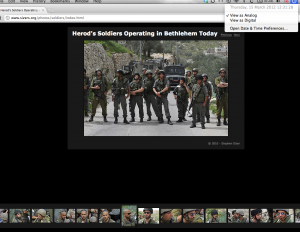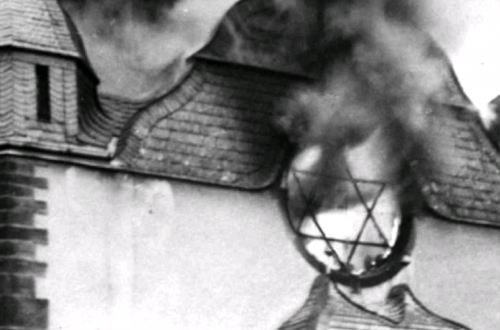This is a guest post by The Rev. Nick Howard
A few hours after the release of yesterday’s CCJ statement about Rev. Stephen Sizer, the Diocese of Guildford issued this reply:
STATEMENT ON BEHALF OF THE BISHOP OF GUILDFORD: by the Diocesan Secretary – Mr Stephen Marriott
The Council of Christians and Jews has drawn to the Bishop of Guildford’s attention their grave concern that the Revd Stephen Sizer – in their words – ‘had been publicizing websites with anti-Semitic content’. The Bishop of Guildford takes this allegation extremely seriously and had already arranged to meet senior members of the Jewish Community to discuss the question. The Bishop has been assured by the Revd Stephen Sizer that he will gladly co-operate with the Surrey Police in relation to this allegation because the CCJ has also drawn attention to the police of what they claim was an action tantamount to encouraging race hatred.
As the Bishop understands the allegation, Mr Sizer drew attention to a political article (not of Mr Sizer’s authorship) the subject of which was possible Israeli Military policy in relation to Iran. No-one however disputes the horrendous and totally unacceptable anti-Semitism of certain other articles on the website. The allegation, as the Bishop understands it, is that Mr Sizer did not withdraw his reference swiftly enough once the nature of the website had been pointed out to him. The Bishop was informed by Mr Sizer that he had taken earlier steps to withdraw the reference, but that these had not effectively removed it, until January of this year. The Bishop had in any case cautioned Mr Sizer about checking the nature of websites before making reference to them. Mr Sizer accepted this criticism and has apologised. Mr Sizer in his published works and in assurances told the Bishop that he is adamant in his opposition to racism and anti-Semitism in particular.
Here are four answers:
1. The statement claims: “The Bishop was informed by Mr Sizer that he had taken earlier steps to withdraw the reference, but that these had not effectively removed it, until January of this year.”
There is nothing easier than removing a link on Facebook. You simply click on the drop-down list next to the link. One of the options is “Delete Post…” Click on that, and a window appears saying: ‘Are you sure you want to delete this?’ There are two buttons: “Delete Post” and “Cancel”. If you click on Delete Post, the link disappears instantly from your page. It’s impossible to believe that someone could accidentally fail to delete a link that they intended to delete. When the Diocese says “he had taken earlier steps to withdraw the reference, but … these had not effectively removed it” they are implying that the process is vastly more difficult and complicated than it actually is. That is misleading. What’s more, as the CCJ’s statement points out (but the Diocese’s reply ignores), Rev. Sizer had two separate opportunities to remove the link, in November and December, before he finally removed it in January.
The November opportunity was a warning given by the Bishop of Guildford to Rev. Sizer about his use of Facebook, following complaints about his link to “The Ugly Truth”. The December opportunity was my own Harry’s Place post about Rev. Sizer, which began by discussing the link to “The Ugly Place”. Rev. Sizer was aware of that post because he issued a response on the same day on his blog. Given the ease of removing a link on Facebook, and the two opportunities Rev. Sizer had to delete it, there can be no doubt that he wanted to carry on recommending “The Ugly Truth” even after receiving complaints about its anti-Semitic nature.
2. The statement says: “As the Bishop understands the allegation, Mr Sizer drew attention to a political article (not of Mr Sizer’s authorship) the subject of which was possible Israeli Military policy in relation to Iran. No-one however disputes the horrendous and totally unacceptable anti-Semitism of certain other articles on the website. The allegation, as the Bishop understands it, is that Mr Sizer did not withdraw his reference swiftly enough once the nature of the website had been pointed out to him.”
The implication here is that Rev. Sizer was originally unaware of the anti-Semitic nature of “The Ugly Truth”, and believed he was recommending a harmless article about foreign relations. The screenshot below shows what Rev. Sizer saw when he read the article and decided to recommend it via Facebook. The imagery surrounding the article, and the tagline for the website, make the idea of a mistaken, innocent recommendation impossible to believe.
3. Another reason why it is inexcusable to give Rev. Sizer the benefit of the doubt is that he has done the same thing in the past. In July 2011 he posted a link on his Facebook page to another racist website (see here). The “Palestine Telegraph” has a high profile. It’s not the kind of website that someone well-versed in the Middle East conflict like Rev. Sizer would ever recommend by accident. By the time Rev. Sizer recommended the “Palestine Telegraph”, Baroness Tonge – previously a “Patron” of the website – had already resigned because of its overt anti-Semitism (shortly before her resignation, the site had posted a video by former KKK Grand Wizard and well-known antisemite David Duke). Two separate recommendations of racist websites confirm deliberate intent.
4. The statement says: “Mr Sizer in his published works and in assurances told the Bishop that he is adamant in his opposition to racism and anti-Semitism in particular.”
Rev. Sizer is hardly likely to say anything else, since doing so would mean that he immediately lost his job. Yet, sadly, there is plenty of evidence in addition to his website recommendations that demonstrates the reality of his anti-Semitism. On at least two occasions he has deliberately highlighted, in a negative context, the Jewishness of non-Israelis. In March 2010, when Hillary Clinton rebuked Israel over settlement building, Rev. Sizer wrote a blog post titled “Payback for Monica”, insinuating that Hillary Clinton’s statement was revenge for her husband’s affair with a Jewish woman. And in March 2011, when it looked as if America might not join the British and French in opposing Libya, Rev. Sizer claimed this could be because of the Gaddafi family’s Jewishness (rumours circulate in Arab countries that Colonel Gaddafi’s mother was Jewish). After mentioning the rumour, Sizer commented, “Blood is indeed thicker than water. Perhaps this is why the US is reluctant to impose a no-fly zone over Libya.” (Rough translation: “Jewish blood gives people a license to commit atrocities, because of the protection offered by the Jewish-funded US government.”) Rev. Sizer has also described Jewish soldiers as “Herod’s soldiers operating in Bethlehem today” (see the screenshot below) which is a reference to the child-killers described in the Gospel of Matthew who sought to murder the Christ.
Anyone familiar with anti-Semitism will recognise two age-old blood libels squeezed into that one statement: that Jews habitually kill Gentile children (Bethlehem is an Arab town), and that each and every Jew is a would-be Christ killer. The offensiveness of this statement was pointed out to Rev. Sizer as long ago as March 2010, but it can still be found on his website today.
The Diocese of Guildford is acting like a judge who calls off a trial as soon as a defendant says “not guilty”. Why does the Diocese take Rev. Sizer’s pleas of innocence at face value? Why does it jump to his defence with a misleading explanation of his delay in removing his link to “The Ugly Truth”? It’s extremely rare for a bishop to criticise a vicar in another bishop’s diocese, but that is what the Bishop of Manchester boldly did in yesterday’s CCJ statement. Why did the Diocese of Guildford reply on the very same day, without any thoroughgoing reconsideration of its support for Rev. Sizer?
The Jewish community is entitled to clear answers to these questions.




